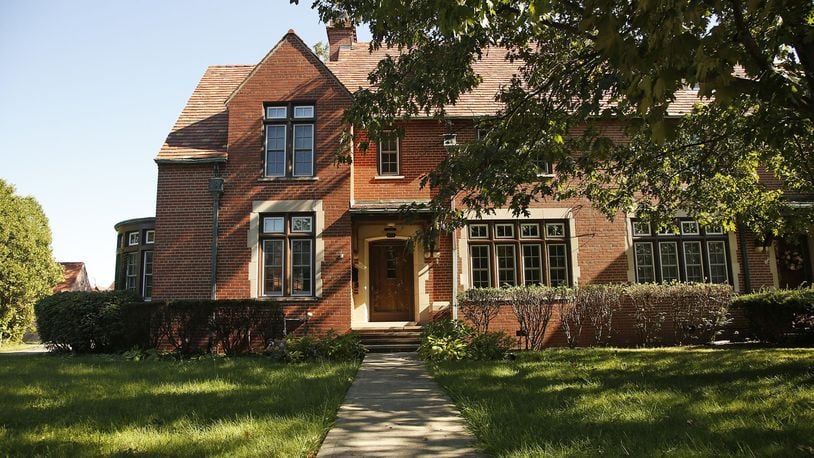“This housing on the Wright-Patt campus is in need of rehabilitation to meet current safety standards and this funding will ensure the buildings are updated to best support those living in the historic homes on the base,” the office of Sen. Sherrod Brown, D-Ohio, said in a press release.
» RELATED: F-35 fighter jet program won’t be fully operational at Wright-Patt until 2022
The homes were built between 1934 and 1937 and were designed in the Tudor Revival-style. They are among the last of government-owned housing on the base, officials have said. They are home to 30 “key and essential” senior military and civilian leaders who officials said must live on base because of their crucial roles in the event of an emergency.
In 2017, the Air Force began exploring options for the brick quarters, including renovation, privatization and demolition. The base also considered building new homes.
An idea to use the homes as temporary lodging was dropped because residents objected to the idea of them being used as “transient housing,” Michael D. Ackerman, an Air Force Civil Engineer Center planning expert at Joint Base San Antonio, Texas said in 2017.
As of two years ago, a major renovation would have cost up to $700,000 per home. A less extensive upgrade focused just on repairs would reach about $150,000 per house, Ackerman has estimated.
Around 17 years ago, Wright-Patterson privatized more than 1,500 residences, but an Air Force study concluded those remaining “are not of adequate size and are not close enough” to the key leaders work sites to be considered alternatives.
An environmental review found there would be no adverse impacts to the environment if the brick homes were demolished. But, the study noted a “major impact” on the historic district’s “cultural landscape” if the old houses were torn down.
The Air Force in 2009 and 2010 spent $1.24 million plus $77,000 in furnishings to renovate a building near these homes - the Charles Taylor House at Wright-Patt. The 3,500-square-foot on-base home was updated to serve as a hotel for VIP visitors.
Other Wright-Patt Funding
Along with the possibility of renovation funding, Wright-Patt also stands to get millions more from the Senate version of the NDAA.
As is, the bill would provide $1.39 billion for research and development programs run in the Air Force Research Lab at the base, according to the offices of Brown and Sen. Rob Portman, R-Ohio. An additional $117 million would be allocated to support Defense Production Act projects and jobs at Wright-Patt and across the nation.
The Senate’s NDAA would also provide $74 million more toward construction of the new National Air and Space Intelligence Center. The intelligence agency analyzes adversaries air, space, and cyber threats, such as ballistic missile capabilities, and provides findings to the nation’s political and military leaders.
» RELATED: Once erased from the map, 150-year-old Dayton VA tunnel could be reopened
“This bill will make sure Wright-Patt’s highly-skilled workers can continue to do their jobs and help meet our national security needs,” Brown said.
In total, NASIC will have received around $182 million for its expansion. NASIC received the first $61 million for construction earlier this year.
NASIC has pressed the need for the new space to relieve overcrowding, agency spokeswoman Michelle Martz has said. The size of the new building will “certainly put a dent in that problem,” she said.
As national decision makers and others have demanded more intelligence, NASIC’s workforce has increased by about 1,500 employees, or 100 a year between 2000 to 2015, according to the agency.
The building will bring employees in six different locations into one facility. The expansion could add 900 seats to house intelligence analysts and engineers and add labs.
» RELATED: VA secretary visiting Dayton criticized for pro-Confederacy comments
“(I) saw many of our intelligence professionals performing highly technical, 21st-century work in World War II-era facilities,” Portman said in a prepared statement. “NASIC plays a critical role in helping the leadership of our country understand foreign threats to U.S. air and space operations and deserves modern facilities befitting of its work.”
The NASIC project drew attention earlier this year when it appeared on a Pentagon list as a possible source to shift funds from to build Trump’s wall at the Mexican border. Altogether, the list named around $112 million of military project dollars in Ohio.
Rep. Mike Turner, R-Dayton, serves as the ranking member on the House Armed Services Subcommittee on Strategic Forces. and he came out against the plan to take money from the NASIC project to fund the border wall. Turner “is committed to continuing to work with the administration to make this expansion at Wright-Patt a reality,” spokeswoman Morgan Rako said in March.
The house is expected to consider its version of the NDAA the week after the Fourth of July holiday, Rako said. If it’s approved, Rako said the bills will be reconciled in a conference of legislators.
“I will work to the utmost of my ability for a final defense bill in conference that is something we can support on a bicameral and bipartisan basis,” Turner said.
FIVE FAST READS
• Air show attendance takes a dramatic dive
• Dayton in the spotlight: MSNBC town hall event discuses presidential race
• Central State, Wilberforce to merge some operations, campus services
• Stories of Survival: Brookville couple feels ‘lucky’ to be alive after tornado outbreak
• State proposal could lower college tuition for active duty military
NDAA by the numbers
$35.7 million: Amount Senate approved to renovate houses.
29: Number of brick quarters that may be updated at Wright-Patt.
$74 million: Amount Senate approved for next phase of NASIC project.
$182 million: Total NASIC project cost at Wright-Patt.
900: Seats added to house intelligence analysts and engineers at NASIC.
$1.39 billion: Amount coming to the Air Force Research Lab at the base.
About the Author
